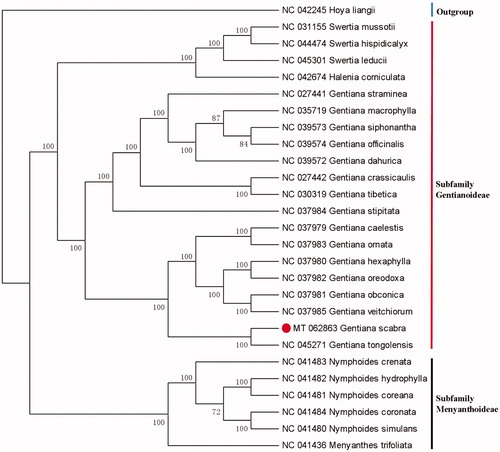Abstract
The first complete chloroplast (cp) genome of Gentiana scabra was determined from Illumina paired-end sequencing data in this study. The cp genome of G. scabra is 146,915 bp in length with 37.84% overall GC content, including a large single copy (LSC) region of 79,350 bp and a small single copy (SSC) region of 17,027 bp, which are separated by a pair of inverted repeats (IRs) of 25,269 bp. The cp genome is composed of 130 genes, including 85 protein-coding genes, 8 rRNA genes, and 37 tRNA genes. Phylogenetic analysis indicated that the G. scabra is more closely related to subfamily of Gentianoideae than Menyanthaceae.
Gentiana scabra Bunge is an perennial herbaceous of the family Gentianaceae, and commonly known as ‘Longdan’ in Chinese herbal medicine, which mainly distributed in temperate climates such as China, Japan, South Korea, Russia, and North America (Li et al. Citation2015). In East Asia, the roots of G. scabra Bge. have been traditionally used to treat inflammatory diseases, anorexia, hepatitis, and indigestion, as well as to relieve fever (Huey-Jiun et al. Citation2011; Yu-Min et al. Citation2015). Although some studies have tried to reveal the inter-specific relationship of Gentiana by ITS, rbcL, and trnL-F etc. (Wong et al. Citation2013), the evidence was not strong enough to prove it. It is well known that the chloroplast (cp) genome can provide effective information on studying the phylogenetic relationship of the plant species. However, such information of G. scabra is limited. Herein, we characterized the cp genome of G. scabra and constructed the phylogeny tree, which will provide more evidence to understand the genome and phylogenetic relationship of the Gentianaceae.
Fresh leaves of G. scabra were collected from Nandao villege (N26°53′57″, E108°27′32″) of Tainan City (Guizhou province, China). The voucher specimen was deposited at the herbarium of institute of Chinese materia medica, China academy of Chinese medical sciences (HBGP0421). Total DNA was extracted using the DNeasy plant mini kit (QIAGEN), and then the paired-end library was sequenced using Illumina NovaSeq platform (San Diego, CA, USA). About 4.70 Gb of raw data (31,352,166 reads) were assembled into a circle contig by NOVOPlasty v3.7 (Dierckxsens et al. Citation2017), and the assembled cp genome was annotated using GeSeq (Michael et al. Citation2017). The annotated cp genome was deposited in the NCBI GenBank under the accession number MT062863.
The cp genome of G. scabra is 146,915 bp in length with four sub-regions: 79,350 bp of large single-copy (LSC) region and 17,027 bp of small single-copy (SSC) region, which are separated by two inverted repeats (IRs) region of 25,269 bp. It contains 130 genes, including 85 protein-coding genes, 8 ribosomal RNA genes, and 37 transfer RNA genes. The total GC content of G. scabra is 37.84%. To confirm the phylogenetic position of G. scabra, a total of 26 cp genomes were downloaded from the NCBI database used for phylogenetic analysis. The sequences were aligned by MAFFT v7.307 (Katoh and Standley Citation2013), and maximum likelihood (ML) tree was constructed with 1000 bootstrap replicates by RAxML (Alexandros Citation2014), with Hoya liangii (NC_042245) as outgroup. Phylogenetic tree showed that the G. scabra is more closely related to the subfamily of Gentianoideae than Menyanthaceae (), which was consistent with the most recent report (Wang et al. Citation2017; Sun et al. Citation2019). The cp genome will provide a valuable resource for the conservation genetics as well as for the phylogenetic studies of Gentianoideae.
Disclosure statement
No potential conflict of interest was reported by the author(s).
Additional information
Funding
References
- Alexandros S. 2014. RAxML version 8: a tool for phylogenetic analysis and post-analysis of large phylogenies. Bioinformatics. 9(30):1312–1313.
- Dierckxsens N, Mardulyn P, Smits G. 2017. NOVOPlasty: de novo assembly of organelle genomes from whole genome data. Nucleic Acids Res. 4(45):e18.
- Huey-Jiun K, Jyun-Han C, Teik NL. 2011. Hepatoprotection of Gentiana scabra extract and polyphenols in liver of carbon tetrachloride-intoxicated mice. J Environ Pathol Tox. 3(30):179–187.
- Katoh K, Standley DM. 2013. MAFFT Multiple Sequence Alignment Software Version 7: improvements in performance and usability. Mol Biol E. 30(4):772–780.
- Li W, Zhou W, Shim SH, Kim YH. 2015. Chemical constituents of the rhizomes and roots of Gentiana scabra (Gentianaceae). Biochem Syst Ecol. 61:169–174.
- Michael T, Pascal L, Tommaso P, Axel F, Ralph B, Stephan G. 2017. GeSeq-versatile and accurate annotation of organelle genomes. Nucleic Acids Res. 45(W1):W6–W11.
- Sun SS, Wang H, Fu PC. 2019. Complete plastid genome of Gentiana trichotoma (Gentianaceae) and phylogenetic analysis. Mitochondr DNA B. 4(2):2775–2776.
- Wang XF, Yang N, Su J, Zhang H, Cao XY. 2017. The complete chloroplast genome of Gentiana macrophylla. Mitochondr DNA B. 2(2):395–396.
- Wong KL, But PP, Shaw PC. 2013. Evaluation of seven DNA barcodes for differentiating closely related medicinal Gentiana species and their adulterants. Chin Med. 8(1):16.
- Yu-Min H, Shu Z, Yue-Wei G, Kohei K, Kun Z, Shao-Qing C, Katsuko K. 2015. The anti-inflammatory secoiridoid glycosides from gentianae scabrae radix: the root and rhizome of Gentiana scabra. J Nat Med. 69(3):303–312.

